Nature & Environment
We take the bike for short errands – but also the car
- 6 Intensity of passenger traffic by transportmode
- 7 Energy efficiency of new cars
- 8 Price changes for transport
- 9 Transport sector co² emissions
The transport sector is one of the sectors causing the greatest environmental impact; and transport continues to increase. the way society is developing has caused rapidly increasing demand for transport in step with the economic development. With continued economic development, we can expect more passenger and freight transport, if the present trend continues. mobility in many ways is a prerequisite for development. But at the same time, this prerequisite for continued growth can be undermined if the growth in traffic leads to congestion or deterioration of the urban environment.
The transport sector consumes non-renewable resources and is dependent on oil. Half of Denmark's total oil consumption today stems from transport.
The transport sector causes about 30 per cent of Co² emissions, and this share is increasing. air pollution from traffic also causes regional and local problems. the discharge of nitrogen oxides, for example, contributes to acidification of lakes and watercourses.
Six out of ten households have a car, but the best thing you can do for cleaner air and less noise is to leave your car at home. take the bike or use public transport as often as possible. there is no sense in taking the car to soccer practice or the local fitness centre close to where you live. the same applies for other small errands you do in your spare time, such as fetching bread from the baker's. it is the short trips in your car on a cold engine that pollute the most. even if you cannot get around using the car, there is still a lot you can do for the environment. You can make environmental considerations a part of your driving behaviour and at the same time save petrol, or you can arrange a carpool with others.
If you follow this advice, you will avoid or minimise air pollution that can harm human health and pollute nature. You help reduce global warming, road noise and the risk of traffic accidents.
6 Intensity of passenger traffic by transportmode
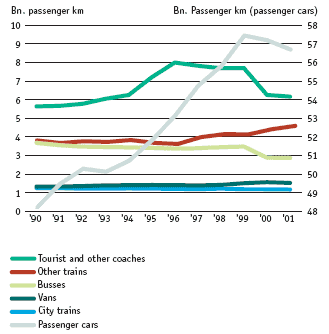
Source: Transport 2000, Statistics Denmark and the Road Directorate
Overall passenger traffic intensity has increased from 1990 to 2001 by almost 17 per cent. Since 1996, passenger traffic by train has increased relatively steeply, partly because of the opening of a fixed link between the islands of Funen and Zealand.


Common sense in traffic gives more life
• If you take the train or bus instead of the car to work or school for an entire year, and the distance is about 20 km each way, you will spare the environment from 800 kg of Co², corresponding to 300 l of petrol.
• If you avoid taking the car on short trips and use the bike or walk instead, you spare the environment for almost an entire kilo of carbon dioxide per trip. Plus you get some exercise as well.
• Each time you leave the car at home, you avoid polluting the air with particles. Particle pollution is one of the major environmental problems. Particles come mostly from the exhaust of diesel cars, but certain types of petrol cars also emit particles. Furthermore, both petrol and diesel cars contribute to particle pollution from tear on brakes, tyres and the road. the smallest particles are the most harmful; since they are so small they can travel far down into the lungs without being coughed up. Here they may harm the lungs or they may enter the bloodstream and cause cardiovascular disease. the particles can also carry other pollutants, for example the tar substances PaHs which are carcinogenic. Particles are the cause of cardiovascular diseases, respiratory disorders, allergies and cancer. in Denmark alone, about 3,400 people die prematurely each year due to particle pollution.
• Each time you leave the car at home, you also avoid creating the nitrogen compounds that can lead to acidification of watercourses and lakes. Hydrocarbons and nitrogen compounds can also irritate the respiratory system, and some hydrocarbons are carcinogenic.
• Each time you leave the car at home, you also reduce emissions of Co² to the atmosphere, one of the most important reasons for climate change. the transport sector alone accounts for about 30 per cent of overall emissions.
• Each time you leave the car at home, you moreover reduce noise pollution and the risk of road accidents. Car traffic in the cities is a substantial source of noise, and noise can lead to problems in the form
of stress, high blood pressure and reduced ability to function for the people exposed to the noise. according to a conservative estimate, road noise causes 200-500 premature deaths annually (from cardiovascular disease and high blood pressure).
7 Energy efficiency of new cars
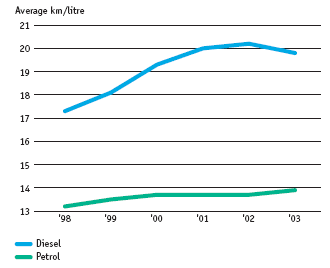
Source: The Ministry of Transport and Statistics Denmark
Energy efficiency is an indicator for the resource consumption as well as the Co² emissions of passenger cars. the better the energy efficiency of the car, the fewer grams of Co²/km it will emit. Despite the fact that the weight of cars continues to increase slightly, the average energy efficiency of new cars has gone up.
Newly registered diesel cars still take the lead. their energy efficiency has increased from
17.3 km/l in 1998 to 19.8 km/l in 2003, which corresponds to an increase of 14.5 per cent.
The development in the average energy efficiency of newly registered petrol cars has not been nearly as favourable, with an increase of about 5 per cent, from 13.3 km/l in 1998 to 13.9 km/l in 2003.
In the period 1998 to 2003, the proportion of diesel cars of the total number of new cars sold increased from about 6 per cent to 20 per cent. this means a reduction in total Co² emissions. in 2003, the average emissions of Co² from new diesel cars was 141 g/km, which is very close to the goal of 140 g/km in 2008 agreed between the european Commission and the car industry. However, diesel cars are not an unmitigated success, since diesel cars have higher emissions of Nox and particles than petrol cars. therefore, an exclusive favourisation of diesel cars will mean a reduction in effects on the climate, but will increase the impact on the local environment.
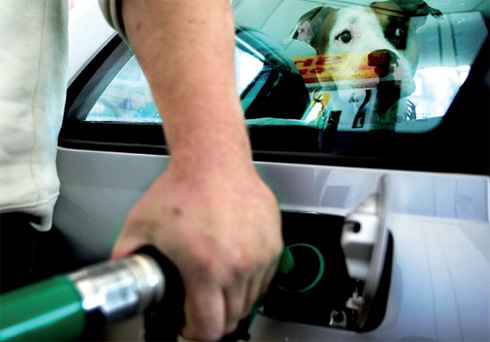
8 Price changes for transport
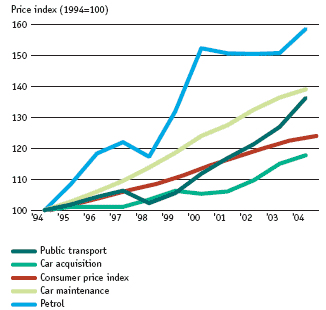
Source: Statistics Denmark
This graph illustrates the changes in the costs of private cars and public transport during the period 1994 to 2004. the trend is compared against the general price development (average consumer price index). the cost of petrol rose considerably in the late 1990s, and prices remained stable at this level in the years 2000-2003. Between 2003 and 2004, petrol prices went up markedly, mainly due to the general global increase in oil prices.
The cost of maintaining a car has increased steadily and more than the average consumer price
Index over the whole period 1994-2004. the cost of acquisition, however, has not risen nearly as much as general prices. From 2002, prices of cars show a more steep increase.
The price index for public transport has been higher than the average consumer price index since 2001. one of the reasons is that the state removed the subsidy for public transport ticket prices with effect from 2004. at the eu Summit in Gothenburg in 2001, it was concluded that the cost of transport should more accurately reflect the costs which it imposes on society.
9 Transport sector co² emissions
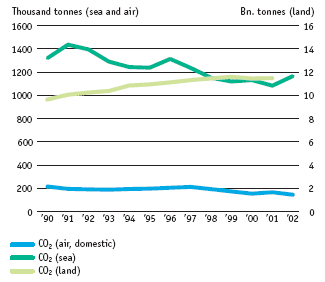
Source: The National Environmental Research Institute
This indicator describes the transport sector's Co² emissions. the transport sector accounts for more than 30 per cent of Denmark's total emissions of greenhouse gases (Co²). transport sector emissions increased by about 14 per cent from 1990-2001. in 2001, road transport accounted for more than 90 per cent of the transport sector's overall Co² emissions.
Furthermore, other environmental impact by the transport sector covers several different types of emission. in Danish cities, traffic makes up the largest source of air pollution. the acidifying substances from traffic are primarily nitrogen oxides (Nox), volatile organic compounds
(NmvoCs), sulphur dioxide (So²), as well as particles and carbon monoxide (Co).
Despite increasing traffic, emissions of Nox, NmvoC and Co have dropped. this is due partly to the 1990 requirement for catalytic converters on new petrol cars, and partly to the introduction of cleaner fuels. in the period 1988 to 1998, the proportion of cars with catalytic converters rose from zero to more than 50 per cent of cars.

Version 1.0 July 2007, © Danish Environmental Protection Agency